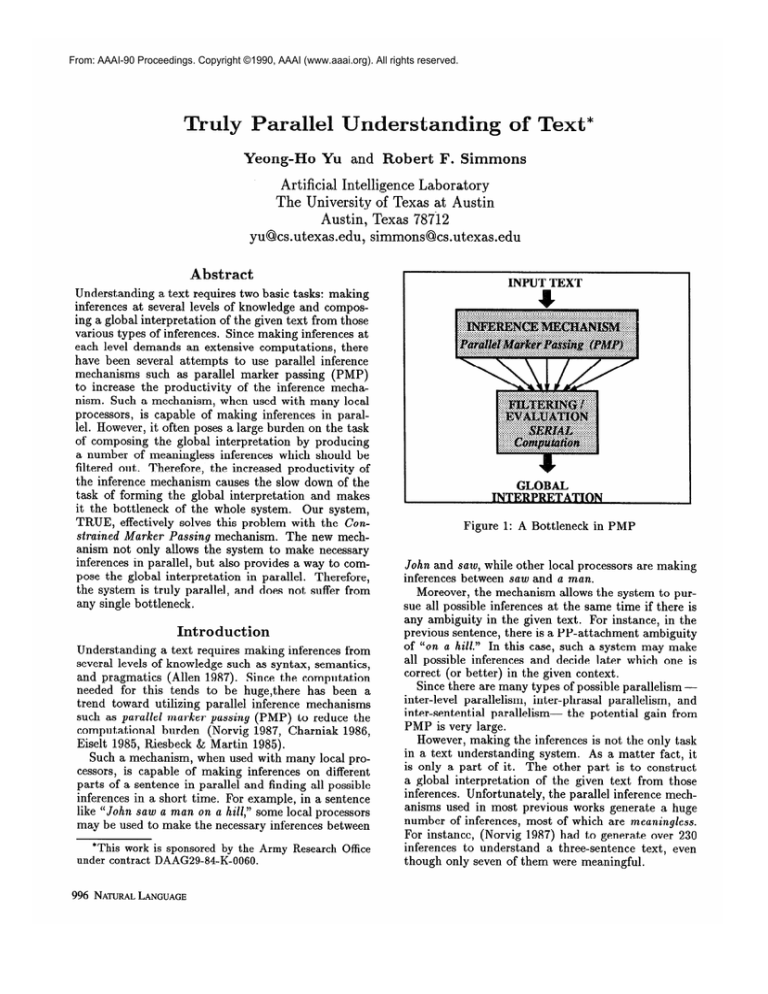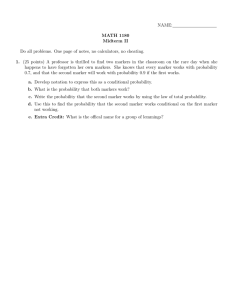
From: AAAI-90 Proceedings. Copyright ©1990, AAAI (www.aaai.org). All rights reserved.
u
uly Parallel
Yeong-Ho
Yu
g
and Robert
of
Text*
F. Simmons
Artificial Intelligence Laboratory
The University of Texas at Austin
Austin, Texas 787’12
yu@cs.utexas.edu,
simmons@cs.utexas.edu
Abstract
Understanding a text requires two basic tasks: making
inferences at several levels of knowledge and composing a global interpretation of the given text from those
various types of inferences. Since making inferences at
each level demands an extensive computations,
there
have been several attempts to use parallel inference
mechanisms such as parallel marker passing (PMP)
to increase the productivity
of the inference mecha
nism. Such a mechanism, when used with many local
processors, is capable of making inferences in parallel. However, it often poses a large burden on the task
of composing
the global interpretation
by producing
a number of meaningless inferences which should be
filtered out. Therefore, the increased productivity
of
the inference mechanism causes the slow down of the
task of forming the global interpretation
and makes
it the bottleneck
of the whole system.
Our system,
TRUE, effectively solves this problem with the Constrained Marker Passing mechanism.
The new mechanism not only allows the system to make necessary
inferences in parallel, but also provides a way to compose the global interpretation
in parallel. Therefore,
the system is truly parallel, and does not suffer from
any single bottleneck.
Introduction
Understanding
a text requires making inferences from
several levels of knowledge such as syntax, semantics,
and pragmatics
(Allen 1987). Since the computation
needed for this tends to be huge,there has been a
trend toward utilizing parallel inference mechanisms
such as parallel marker passing (PMP) to reduce the
computational
burden (Norvig 1987, Charniak 1986,
Eiselt 1985, Riesbeck & Martin 1985).
Such a mechanism, when used with many local processors, is capable of making inferences on different
parts of a sentence in parallel and finding all possible
inferences in a short time. For example, in a sentence
like “John saw a man on a hill,” some local processors
may be used to make the necessary inferences between
*This work is sponsored by the Army
under contract DAAG29-84-K-0060.
996 NATURALLANGUAGE
Research Office
INPUT TEXT
+
GLOBAL
Figure 1: A Bottleneck
in PMP
John and sutu, while other local processors are making
inferences between suw and a man.
Moreover, the mechanism allows the system to pursue all possible inferences at the same time if there is
any ambiguity in the given text. For instance, in the
previous sentence, there is a PP-attachment
ambiguity
of “on a hill.” In this case, such a system may make
all possible inferences and decide later which one is
correct (or better) in the given context.
Since there are many types of possible parallelism inter-level parallelism,
inter-phrasal
parallelism,
and
inter-sentential
parallelismthe potential gain from
PMP is very large.
However, making the inferences is not the only task
in a text understanding
system. As a matter fact, it
is only a part of it. The other part is to construct
a global interpretation
of the given text from those
inferences. Unfortunately, the parallel inference mechanisms used in most previous works generate a huge
number of inferences, most of which are meaningless.
For instance, (Norvig 1987) had to generate over 230
inferences to understand a three-sentence
text, even
though only seven of them were meaningful.
Figure 2: TRUE Architecture
Figure 3: Parallel Marker Passing
Therefore, a fibtering/evabuation
step is needed to remove those meaningless inferences. Also, to find the
best interpretation in the presence of ambiguities, the
filtering/evaluation step often has to compare several
inferences and has to be implemented as a serial process like Figure 1. From the system’s viewpoint, the
filtering step tends to be the bottleneck of the whole
system, and negates the benefits of PMP.
Our system, TRUEl, solves the problem in two
ways. First, it reduces the number of total inferences
by pruning meaningless inferences as soon as possible and by utilizing the interactions of three levels of
knowledge so that only necessary inferences are made.
Secondly, TRUE distributes the filtering step over local processors so that there is no single bottleneck.
The basic mechanism behind all of these is a parallel
mechanism called Constrained Marker Passing, which
is the subject of the next section.
Constrained
Marker
Passing
Figure 2 shows the architecture of TRUE with its three
levels of knowledge: syntax, semantics, and pragmatits. All three levels are homogeneous in their representation and processing mechanisms: they each use a
network of connected nodes2 to represent their knowledge and all use a parallel mechanism called Constrained Marker Passing (CMP) in making inferences.
The result of the whole computation is a text network
that represents an understanding of the given text in
the form of a connected, coherent network of semantic
concepts. Initially, the text network is empty. When a
new sentence is read, the system makes nodes for all
‘It stands for True Readers
Understand
Efficiently.
2Even though
concept,
otode, and locasl processor- are
three different entities,
they are used interchangeably
in
this paper. The actual distinction
is that a concept is represented as a pzode in our network representation
while a
node is implemented
by a loccal processor in our parallel
implementation.
possible concepts for each word in the sentence3, while
connecting them to the syntactic category nodes and
semantic superclass nodes in the knowledge network
as well as to the nodes for the words in the sentence4.
Managing the text network and creating new nodes for
newly-inferenced relations among concepts in the text
network are the only tasks required of the central process; all other computations are localized in the nodes.
Like all the other parallel marker passing mechanisms, CMP finds an inference by detecting the collision of two markers which have traveled through the
connected nodes of the knowledge base. However, it
is different from other parallel marker passing mechanisms in that it has programmable
markers. While
other PMP mechanisms utilize only one or two types
of markers which are passed to all the neighbors indiscriminately and collide with other markers anywhere
as in Figure 3, in CMP, there are many types of markers each of which is constrained to travel only through
pre-defined patterns of paths in levels of the networks
and to interact only with pre-specified markers at prespecified locations as in Figure 4.
The number of markers and the definitions of them
are decided by the programmer. For the given task
of making some specific types of inferences- inference
paths in the networkthe programmer decides how
such paths may be found and defines markers for them.
For instance, in Figure 4, to find a case (or semantic) relation, a programmer defines new types of markers which ascend isa hierarchies and collide with each
other at a case relation.
To help the programmer to define markers easily
and efficiently, TRUE provides Marker Definition Language (MDL).
3Lexical ambiguities
will cause multiple concept nodes
for words, and they will be resolved in the same way as
other types of ambiguities are resolved.
4See Figure 7 for an example of the text network.
YUAND
SIMMONS997
marker
type
CS(case-search)
A marker for finding a case relation.
authorized
path
instxpt.(isa.cpt)*.case-rel
It travels through an instance-of link to a concept node, then, a
chain of isa links and concept nodes to a case relation node.
special
actions
None.
This one has none. However, other types of markers have actions
Markers are &itiated
w
markers from
---+
Figure 4: Constrained
Marker
Definitions
markers from
Marker Passing
and MDL
A marker definition consists of the four fields: marker
type, authorized paths, special actions, and collision
Marker type represents the identificaspecifications.
tion symbol for the marker while authorized paths
specify the pattern of paths which the marker may
travel. These paths are described in the form of regular expressions. Special actions are actions to be taken
in the middle of the paths. Collision specifications define the details of marker collision such as with what
marker to collide, where, when, and what actions to be
taken after a collision.
Currently, MDL is a LISP function and all the values
of the fields are given as arguments of the function.
Figure 5 shows the definition of the marker used in
Figure 4. Note that the patterns are given as regular
expressions and may be used to find an infinite number
of different paths.
Marker
Processing
Tables
Even though it is easier for the programmer
to envision a marker as an active entity which travels the
network for itself, and to define the definition for it,
in the actual implementation
, a marker is a passive
entity passed around by the local processors (nodes).
Therefore, it is the responsibility
of the nodes to process the markers appropriately.
The instructions of how to handle arriving markers
are given as a table called the Marker Processing Table (MPT).
This table has four fields: marker type,
conditions,
actions, and out-going markers, and may
have several entries for different types of markers. The
algorithm for processing markers at a node is shown
in Figure 6. A marker is terminated when there is no
MPT entry for its type or when the conditions of the
entry fail. Otherwise, the specified actions are taken,
and new markers are passed to the appropriate neighbors.
998 NATURAL LANGUAGE
like getting some values from the nodes in the middle of the path.
with:
CS
where: at the end of the path
when: always
actions: send NC to CP
send ARG to INST
collision
specifics
It collides only with another CS at the end of a path of the defined
pattern under any condition. As a result, a NC marker will be sent
to CP and a ARG marker to INST neighbors.
Figure 5: A Marker Definition
All the nodes use the same algorithm, but have different MPT’s which are compiled from the marker definitions.
Therefore, in the example of Figure 4 and
Figure 5, the MPT’s of all those nodes (i.e., isa, concept, and agent) of the authorized paths have entries
for that type of marker while others don’t.
This algorithm provides an efficient way for automatic terminations of markers as soon as they deviate from the
authorized paths.
Advantages
of CMP
The most important
advantage
of CMP is that,
through careful programming,
the system only generates the necessary inferences without making meaningless ones. Secondly, since the markers are terminated
as early as possible, the marker traffic is very light
compared with other mechanisms.
Since the overall
performance of a parallel system often depends on the
communication
time among local processors, this light
traffic may improve the overall system performance
substantially.
Finally, the programmability
of markers and MDL
provides the programmer with a way to define markers
for fine-gruined
interactions among nodes at different
levels. As it will be shown in the following sections,
through these interactions between levels, TRUE not
only generates the necessary inferences, but also finds
the best inference in the presence of ambiguities.
Three
Levels and Their Interactions
In this section, the summaries of how several kinds
of inferences are made in those three levels and how
ABBREV:
0
CASEREL
NUM: NUMBER
<::3
L-DC: LOCATION
SYNTATIC REL
--_-
MOD: MODIFY
COND link
SPEC: SPECIFY
Figure 7: A Sample Text Network
Figure 6: Algorithm
for Local Processors
interactions between levels minimize the number of inferences generated are presented. More details can be
found in (Yu & Simmons 90).
Each level makes different types of inferences. The
syntax level looks for syntactic relations such as specify and modify which have their origins in x grammar.
Roughly speaking, they are equivalent to the left and
right branches in conventional parse trees. When the
initial text network is instantiated with the given sentence, all the concept nodes in the network send out
markers for syntactic relations.
The markers travel
through the syntax network which has the knowledge
of English grammar such as “an NP specifies a VP”
and “a PP modifies an NP or a VP.” As a result, this
network will find all possible syntactic relations in the
text.
The semantic level searches for case relations among
concepts in the text such as agent between saw and
John or uflected-entity(ae)
between su2u and a man
in the sentence “John saw a man on a hill”.
The
search for a case relation is initiated when a syntactic relation is found in the syntax level. For instance,
in the previous sentence, the new syntax relations between John - saw, saw - a mun, a - hill, etc. initiate
the searches for case relations between those concepts
resulting in the case relations, agent, uflected-entity,
and number respectively.
The rationale behind this
bottom-up interaction is to prevent the system from
finding a syntactically-incorrect
case relation such as
uflected-entity
between saw and a hill, and to reduce
the amount of computation
in the semantic level with
the help from the syntax level.
In TRUE, this interaction is stated in the definition
of markers for the syntactic relations.
That is, the
definitions of the markers for syntactic relations have
collision specifications, a part of which tells the node to
fire markers for case relations when a collision between
two syntactic markers occurs.
Figure 7 shows the text network after the syntax
and semantic levels have made all possible inferences
for the sentence “John saw a man on a hill.” Note that
there are two possible syntactic relations coming out
from “on a hill” due to the PP-attachment
ambiguity.
The dotted linesa graphical abbreviation
for cond
links- connect the related syntactic and case relations.
The pragmatic
level tries to find the coherence
relations between event and state concepts (usually
verbs)(Alterman
1982) in the given text. For instance,
there is a coherence relation(untecedent)
between a
concept give and haveto give something to somebody, one hus to have it first. The knowledge about
this coherence relation can be stated as a rule as below:
If ugent(ownership)
= ugent(ownership-transfer)
and
uflected-entity(ownership)
= uflected-entity(ownership-transfer)
then ownership is an antecedent of ownership-transfer.
This rule requires some argument matchings for the
coherence relation to be instantiated.
This is to prevent a false coherence relation from being inferred. For
instance, it is wrong to infer an antecedent relation between had and gave in the sentences like “John had
an old bike. His father gave him a new bike.”
In the same way that the syntax level activates the
semantic level, the inferences made at the semantic
level activate the search for coherence relations at the
pragmatic level. When a case relation is instantiated as
a node in the text network, it initiates markers which
travel through the part of the pragmatic network which
represents the argument matching conditions.
If all
the conditions of a coherence relation are met through
the collisions of markers from the arguments, then the
coherence relation is instantiated in the text network.
Through this guidance from a low level to a high
level, TRUE accomplishes
the task of minimizing the
YUAND
SIMMONS 999
number of inferences without loosing any valid ones.
There is another type of inference which has not
been described so far. It is that of finding possible
referents for pronouns in the sentence. This is also
done through separate types of markers which are activated as soon as the sentence is instantiated in the
text network.
Distributed
Filtering
There are two reasons for filtering the inferences in
other systems: to eliminate the meaningless inferences,
and to find the best inference out of several inferences
generated from an ambiguity and form a globally coherent interpretation for the given text. In TRUE,
there are no meaningless inferences and subsequently
no need for such elimination. However, TRUE still
generates multiple inferences for ambiguous parts of
the text, and has to find the best one among them.
For instance, in a three-sentence text, “John had
a bike. Bill wanted it. He gave it to him.“, there
are ambiguities in the referents for pronouns he and
him. In the beginning, markers for pronoun referents
find both John and BilZ as possible candidates for both
pronouns.
To resolve this kind of ambiguity, the system has to
depend on the inferences made at the higher levels. For
instance, the inference of a coherence relation between
have and give makes John as the preferable referent for
He since the knowledge says that the agents of have
and give have to be the same to have such a coherence
relation.
In reality, there are many kinds of ambiguities and
this constitutes the biggest problem in understanding
a text. There have been two approaches in finding the
best out of multiple inferences: centralized and distributed.
The centralized approaches like (Charniak 1986,
Norvig 1987) gather all inferences at a central process
and compare them by applying several heuristics. This
approach, even though it is easier to implement, has an
apparent disadvantage over the distributed approach:
the central process may turn out to be the bottleneck
of the system.
Therefore, TRUE takes a distributed approach similar to those of (Waltz & Pollack 1985, Howells 1988).
In these local connectionist systems, each node has a
real value called its activation leveZ and links between
nodes have weights. The activation level of a node is
computed from the sum of the products of the activation levels of neighbors and the weights of the links
between itself and the neighbors. In this scheme, a
negative weight between two nodes indicates that they
are mutually exclusive while a positive weight indicates
that they are mutually inclusive. After a number of cycles, the activation levels of all nodes may converge to
stable values. Then, the nodes with high activation
levels are declared as winners.
However, this approach also has a disadvantage.
That is, the network should be pre-wired with appro-
1000
NATURALLANGUAGE
priate weights. In TRUE, the text network grows as a
new sentence comes in and as new inferences-are made.
So, it has no way to decide the proper weights in advance and has to use another method to compute the
activation levels.
Instead of re-calculating its activation level periodically, a node in TRUE changes its activation level only
when an activation-change
marker arrives either from
a node which is connected to it through a cond link,
or from its competitor. In the first case, the activation level is increased while, in the second case, it is
decreased5. Note that a node is connected to another
through a cond link only when two nodes are at different-levels and they are related. For example, a case
relation is connected to a syntactic rel.ation through a
cond only when the search for the case relation WaS
initiated from the syntactic relation
Therefore, when a marker initiated from a low level
succeeds in 6 nding a relation in a higher
level, the new
_
node for the high level relation sends out an uctivutionchange marker-which will increase the activation level
of the node for the low level relation. This top-down
interaction may be interpreted as the principle that,
when an inference made at a low level results in an
inference at a high level, the inference at the low level
is rewarded through an increase of its activation level.
When the activation level of a node changes, it sends
out activation-change
markers to its competitors and
the nodes which are connected with it through cond
links so that they may adjust their activation levels.
Figure 8 shows a simplified6 final text network of
the three-sentence text mentioned above. In the figure, those concepts and relations which are involved in
the ambiguities are drawn with bold lines, while irrelevant ones are drawn with shaded lines. Two shaded
boxes emphasize two ambiguities resulting from two
prosnouns - He and him. Among those ambiguous
relations, the winners -those that are included in the
global interpretationare drawn with the white background.
In the beginning, the ambiguity of He causes two referent relations (refer-3, refer-d) to be generated, which
in turn enable two ugent relations (agent-3, agent-d) to
be generated and connected to them through cond relations (dotted lines). When an antecedent relation is inferenced between had and gave, the argument matchings increase the activation level of agent-3, which in
turn increases that of refer-3. Then, they decrease the
activation levels of their competitorsagent-4 and
refer-4 respectively.
Discussion
Parallelizing a part of a system does not necessarily improve the overall system performance. In some cases, it
5The amount of
fer (Yu & Simmons
‘For the sake of
relations, and some
change depends on several factors.
90) for more details.
readability,
the syntactic
relations,
other relations are not shown.
Re-
isa
M
1 To
He
1
1Him [
Figure 8: A Simplified Final Text Network
may worsen the system performance by putting a huge
burden on a single bottleneck. Unfortunately, this is
the case for most systems based on parallel marker
passing. Their major bottleneck has been the filtering
step which slows down the system greatly due to the
huge number of meaningless or ambiguous inferences.
TRUE, on the other hand, does not generate any
meaningless inferences and finds the best inference
This is accomamong ambiguous ones efficiently.
plished through Constrained Marker Passing, the bidirectional interactions between three levels of knowledge, and the distributed filtering step.
There are other systems which share some
common characteristics with TRUE. For instance,
(Sumida, Dyer, & Flower 1989) uses another type of
constrained marker passing which is similar to CMP.
However, CMP is more general and powerful and provides a programmer with MDL and its compiler so
that the programmer may define new types of markers
freely without affecting existing ones.
(Norvig 1987, Eiselt 1985) use the technique of
pruning meaningless inferences paths. But, the pruning is done at a centralized process and tends to be the
bottleneck of the systems.
Currently, TRUE is implemented in a Symbolics
LISP machine on top of a simulator for CMP. All the
knowledge base and marker definitions are written in
a format easy for a programmer and compiled into a
knowledge network and a set of MPT’s.
Currently,
there are about thirty types of markers in TRUE. The
implementation of TRUE in the Connection Machine
is under way.
References
Allen, J. 1987. Natural Language Understanding,
jamin/ Bummings Publishing Co.
Ben-
Alterman R-E.. A System of Seven Coherence Relations for Hierarchically Organizing event concepts in
text. Tech Report, TR-209, AI Lab, Univ of Texas.
Charniak, E. 1986. A Neat Theory of Marker Passing.
In Proceedings of the Fifth National Conference on
Artificial Intelligence. Menlo Park, Calif.: AAAI.
Eiselt, K.P. 1985. A Parallel-Process Model of On-Line
Inference Processing. In Proceedings of the Ninth International Joint Conference on Artificial Intelligence.
Menlo Park, Calif.: IJCAI, Inc.
Howells, T. 1988. Vital: A Connectionist Parser. In
Proceedings of the Tenth Annual Conference of the
Cognitive Science Society
P. Norvig. 1987. Unified Theory of Inference for Text
Understanding. Ph.D. diss., EECS, UC Berkeley.
Riesbeck, C.K., and Martin, C.E. 1985. Direct Memory Access Parsing, Technical Report YALEU-DCSRR 354, Dept of Computer Science, Yale University.
Sumida, R.A.; Dyer, M.G.; and Flowers, M. 1988. Integrating Marker Passing and Connectionism for Handling Conceptual and Structural Ambiguities. In Proceedings of the Tenth Annual Conference of the Cognitive Science Society.
Waltz, D.L., and Pollack, J.B. 1985. Massively Parallel
Processing: A Strongly Interactive Model of Natural
Language Interpretation. Cognitive Science, 9( 1).
Yu, Y., and Simmons, R.F. 1990. Bi-Directional Interactions in a Parallel Text Understanding System, Tech
Report, AI90-131, AI Lab, University of Texas.
Yu ANDSIMMONS 1001




